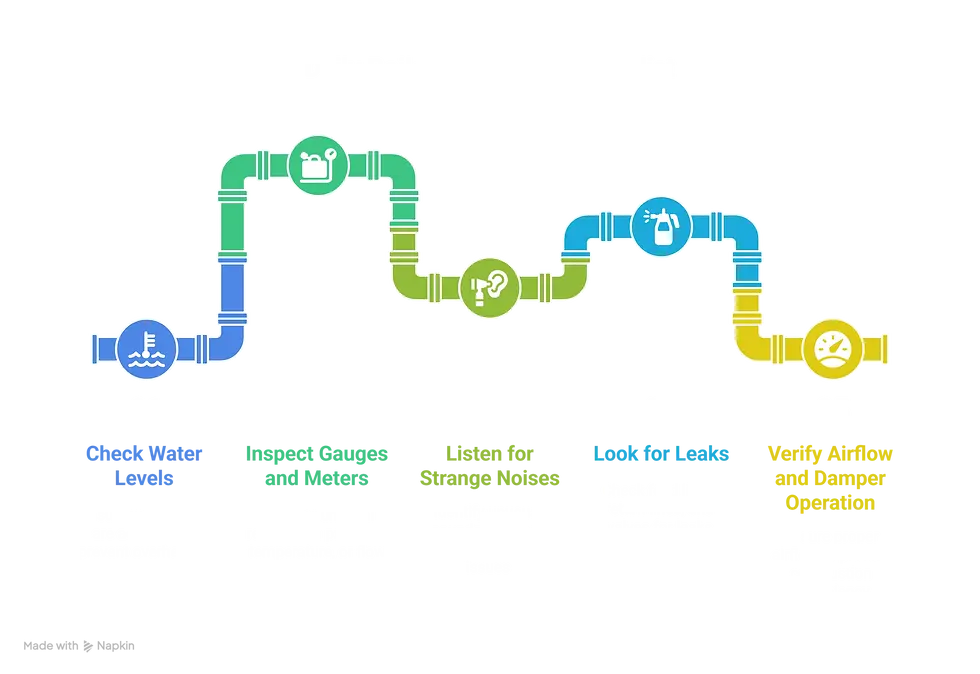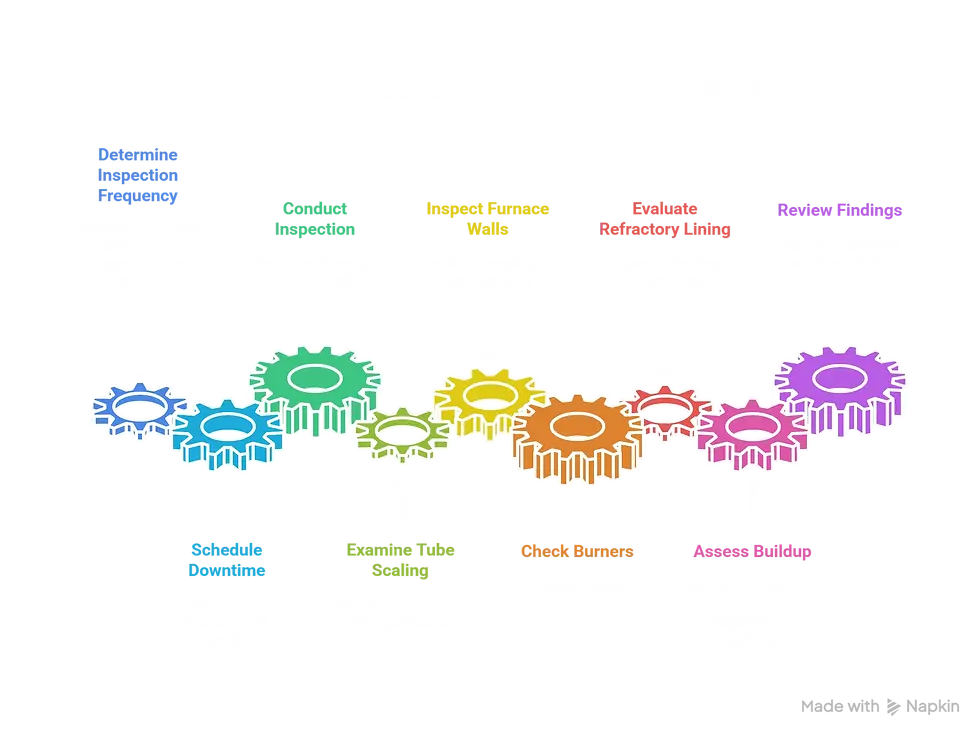Steam Boiler Maintenance Tips for Coal-Fired Systems
- National Coal Suppliers

- Jul 28
- 6 min read
Learn practical, expert-backed maintenance tips for coal-fired steam boilers to boost performance, prevent breakdowns, and extend equipment life in industrial settings.
About the Author: National Coal Supplier is a trusted source for 10,000+ monthly readers seeking industry insights on coal mining, gold, and chrome. Backed by industry analysts and technical writers, we provide accurate data on grades, specs, and sourcing of coal types, including peas, small nuts, and duff, serving buyers, exporters, and energy firms.

Key Takeaways
Regular inspections reduce unplanned shutdowns and safety risks.
Scale buildup and corrosion are major causes of efficiency loss.
Water treatment is critical for boiler longevity.
Keeping accurate logs helps spot issues early.
Partnering with certified professionals ensures compliance and reliability.
Keeping a coal-fired steam boiler in top condition is critical for safety, performance, and fuel efficiency. We've seen how poorly maintained systems can lead to massive heat losses, premature component failure, and skyrocketing operational costs. Whether you're managing an industrial facility or a smaller plant, regular boiler maintenance isn’t optional; it’s essential.
Here’s what companies running coal-fired systems need to prioritize to avoid costly downtime and ensure long-term performance.
LOOKING FOR A RELIABLE COAL SUPPLIER? We source and deliver high quality coal grades including peas, small nuts, duff, and RB1 to meet the needs of local and export buyers. Contact us for pricing, specs, or bulk orders.
What Should You Check During a Daily Inspection?
Daily inspections should be fast but thorough. These checks catch small problems before they escalate into shutdowns. Based on our field experience, here are the most important areas to look at:
Check water levels: Low levels cause overheating and can damage tubes.
Inspect gauges and meters: Look for unusual pressure, temperature, or flow readings.
Listen for strange noises: pinging, knocking, or hissing sounds can signal internal issues.
Look for leaks: Check feed lines, return lines, and valves.
Verify airflow and damper operation: Blocked airflow is a leading cause of combustion inefficiency.
Even experienced technicians sometimes overlook the basics. Set a standard checklist and train staff to log issues immediately. Learn more about how to boost boiler efficiency with the right coal products.

Why Is Soot Blowing So Important?
Coal combustion leaves soot, which clogs heat transfer surfaces. If not removed regularly, it reduces efficiency and raises exhaust temperatures. Over time, we’ve seen facilities lose 5–10% efficiency due to neglecting soot buildup.
Soot blowers should be operated:
Daily or every shift during peak usage
After boiler load changes
After switching coal sources (as ash content varies)
Automated soot blowing systems are ideal, but even manual soot blowing is better than none. Prioritize hard-to-reach zones like superheaters and economizers. Excess soot doesn’t just lower efficiency; it shortens boiler life.
How Often Should You Clean the Ash Handling System?
Ash handling gets overlooked until it becomes a bottleneck. But ash buildup increases backpressure, damages conveyor systems, and affects combustion quality. Our recommendation: inspect and clean components at least once per week.
Typical ash handling system maintenance includes:
Clearing conveyor belt jams
Inspecting scraper bars and paddles
Checking for wear on rotary valves and bearings
Removing slag and clinkers from hoppers
Here's a quick comparison table of cleaning intervals by component:
Component | Cleaning Frequency | Common Issues If Ignored |
Fly Ash Hopper | Weekly | Clogging, pressure imbalance |
Ash Conveyor | Weekly | Belt failure, misalignment |
Rotary Airlock Valve | Monthly | Excess wear, poor sealing |
Sluice System (wet) | Biweekly | Overflow, corrosion |
Staying proactive keeps systems running and avoids expensive repair work. Learn more about the difference between peas and small nuts.
When Should You Schedule a Full Internal Inspection?
A full internal inspection should happen at least once per year. But if your system runs nonstop or uses high-ash coal, you may need to do it semi-annually.
These inspections require downtime but are crucial for long-term reliability. What we typically examine during an internal audit:
Tube scaling or pitting
Furnace wall warping
Burners for erosion or slagging
Refractory lining damage
Buildup in the economizer and superheater sections
Companies that wait too long often face serious surprises. One facility we worked with discovered 30% of their water wall tubes were compromised because no one had looked inside for three years.

What Kind of Water Treatment Is Required?
Boiler feedwater must be treated to prevent corrosion, scaling, and fouling. Untreated or poorly treated water is a leading cause of tube failure and energy loss.
Essential water treatment measures include:
Softening: Removes calcium and magnesium
Deaeration: Eliminates dissolved oxygen
pH control: Prevents acid corrosion or alkaline damage
Chemical dosing: Uses oxygen scavengers and dispersants
A real-world tip: always monitor water conductivity and adjust chemical feed rates accordingly. We’ve seen plants waste thousands on unnecessary chemicals due to poor monitoring. Partner with a water treatment expert and schedule quarterly water analysis.
What Maintenance Is Needed for the Feedwater Pump?
Feedwater pumps must deliver water at consistent pressure. A failure here can shut down the entire system.
To maintain feed pumps:
Inspect shaft seals and replace if leaking.
Lubricate bearings regularly.
Align motor and pump shafts to avoid vibration.
Monitor suction pressure and flow rates.
Backflush strainers every week.
We’ve found that alignment issues are one of the most overlooked problems. Even a 0.1 mm misalignment can increase energy use and reduce pump life.
LOOKING FOR A RELIABLE COAL SUPPLIER? We source and deliver high quality coal grades including peas, small nuts, duff, and RB1 to meet the needs of local and export buyers. Contact us for pricing, specs, or bulk orders.
How Do You Extend the Life of Boiler Tubes?
Boiler tube replacement is costly and often avoidable. Tube wear is usually caused by corrosion, overheating, or erosion from fly ash. Preventive steps make a measurable difference.
Here’s what we advise:
Maintain proper water chemistry.
Soot blow regularly to reduce tube fouling.
Monitor flame shape and burner alignment.
Use tube shields in high-wear areas.
Conduct ultrasonic thickness testing annually.
A common mistake is ignoring burner flame impingement. If the flame hits tubes directly, they’ll fail early, even if everything else is fine.
Frequently Asked Questions
How often should safety valves be tested on a coal boiler?
Safety valves should be tested at least every three to six months depending on the pressure class and operating hours. In high-demand industrial setups, we’ve found quarterly testing is more realistic to ensure consistent performance. Sudden pressure spikes can occur without warning, and a stuck safety valve can turn a minor issue into a catastrophic failure. Always document test results and include them in your boiler’s maintenance log to maintain compliance and traceability.
What is the best way to prevent slagging in coal-fired boilers?
Slagging is caused by impurities in coal melting and sticking to furnace walls. The best prevention method is to monitor the ash fusion temperature of your coal and keep furnace temperatures within an optimal range. Adding additives that increase the melting point of ash can help, as can maintaining good burner alignment. We’ve seen facilities drastically reduce slagging by switching to low-sodium coal blends or using real-time combustion controls that adjust air-fuel ratios based on sensor data.
Can poor draft control affect coal boiler efficiency?
Absolutely. Draft control regulates the flow of air and flue gas through the boiler. Poor draft can result in incomplete combustion, soot buildup, and pressure imbalance. We’ve worked with plants that saw a 3–5% improvement in efficiency after upgrading to variable frequency drives (VFDs) and modern dampers. Proper draft tuning also helps stabilize flame patterns and reduces wear on boiler internals. This is especially important in older systems with manual dampers.
What role does flue gas temperature play in maintenance?
Flue gas temperature is a key indicator of heat transfer efficiency. If flue temperatures are too high, it often means heat isn’t being effectively transferred to the steam circuit, usually due to soot or scaling. We recommend tracking trends over time. A sudden rise could signal fouling in the economizer or superheater. Keeping flue temps in the manufacturer’s recommended range improves fuel efficiency and reduces wear on exhaust components.
How can I train staff effectively for routine maintenance?
Start with hands-on training sessions paired with clear visual guides or SOPs. We’ve seen success using laminated checklists at key points in the boiler room, daily inspection points, feedwater systems, and control panels. Pair less experienced staff with a seasoned technician for at least two full maintenance cycles. Encourage questions, document recurring issues, and consider quarterly refresher courses. Well-trained staff prevent 90% of avoidable issues.



